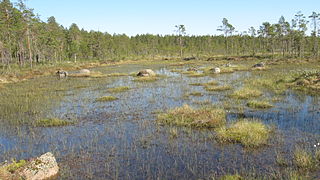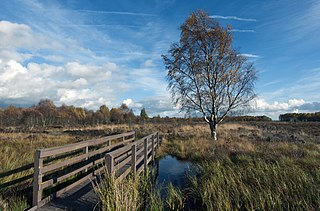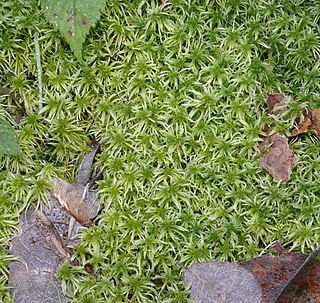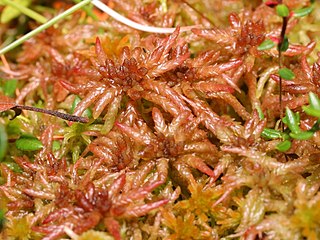Related Research Articles

A bog or bogland is a wetland that accumulates peat as a deposit of dead plant materials – often mosses, typically sphagnum moss. It is one of the four main types of wetlands. Other names for bogs include mire, mosses, quagmire, and muskeg; alkaline mires are called fens. A bayhead is another type of bog found in the forest of the Gulf Coast states in the United States. They are often covered in heath or heather shrubs rooted in the sphagnum moss and peat. The gradual accumulation of decayed plant material in a bog functions as a carbon sink.

Sphagnum is a genus of approximately 380 accepted species of mosses, commonly known as sphagnum moss, also bog moss and quacker moss. Accumulations of Sphagnum can store water, since both living and dead plants can hold large quantities of water inside their cells; plants may hold 16 to 26 times as much water as their dry weight, depending on the species. The empty cells help retain water in drier conditions.
This article gives an overview of the heath communities in the British National Vegetation Classification system.
NVC community M20 is one of the mire communities in the British National Vegetation Classification system.
NVC community M2 is one of the mire communities in the British National Vegetation Classification system.
NVC community M3 is one of the mire plant communities in the British National Vegetation Classification system.
NVC community H5 is one of the heath communities in the British National Vegetation Classification system. It is one of three communities which are considered transitional between the lowland dry heaths and the wetter communities classified in the NVC as mires.
NVC community M4 is one of the mire communities in the British National Vegetation Classification system.

Neottia cordata, the lesser twayblade or heartleaf twayblade, is an orchid of upland bogs and mires that rarely exceeds 15 cm (5.9 in) in height. It was formerly placed in the genus Listera, but molecular phylogenetic studies have shown that Neottia nidus-avis, the bird's-nest orchid, evolved within the same group.

Cors Caron is a raised bog in Ceredigion, Wales. Cors is the Welsh word for "bog". Cors Caron covers an area of approximately 349 hectares. Cors Caron represents the most intact surviving example of a raised bog landscape in the United Kingdom. About 44 different species groups inhabit the area including various land and aquatic plants, fish, insects, crustaceans, lichen, fungi, terrestrial mammals and birds.

Flanders Moss is an area of raised bog lying in the Carse of Forth in west Stirlingshire, Scotland. The villages of Thornhill and Port of Menteith lie to the north with the villages of Kippen and Buchlyvie lying to the south. The moss is a National Nature Reserve, managed by NatureScot. Formed on the Carse of Stirling over 8000 years ago, it is an internationally important habitat currently undergoing active restoration. The eastern part of Flanders Moss is the largest raised bog in Europe to remain in a predominantly near-natural state.

Aulacomnium palustre, the bog groove-moss or ribbed bog moss, is a moss that is nearly cosmopolitan in distribution. It occurs in North America, Hispaniola, Venezuela, Eurasia, and New Zealand. In North America, it occurs across southern arctic, subboreal, and boreal regions from Alaska and British Columbia to Greenland and Quebec. Documentation of ribbed bog moss's distribution in the contiguous United States is probably incomplete. It is reported sporadically south to Washington, Wyoming, Georgia, and Virginia.

Sphagnum angustifolium, the fine bogmoss, is a species of peat moss with a Holarctic distribution. A member of the S. recurvum species complex within Sphagnum section Cuspidata, it is a relatively small, green to yellowish moss that grows in wet, moderately nutrient-rich mires, typically forming carpets or growing intermixed with other peat moss species. The species can be distinguished from its close relatives by having no more than four branches per fascicle and distinctive large pores on its hanging branch leaves, though identification becomes more challenging in southern populations where morphological characteristics are less distinct.

Sphagnum girgensohnii, commonly known as Girgensohn's bogmoss, Girgensohn's sphagnum or common green peat moss, is a species of peat moss with a Holarctic and Indo-Malesian distribution. First described by Edmund Russow in 1865, it is a relatively robust moss species characterised by its green to straw-coloured appearance and distinctive branching pattern. The species typically grows in shaded, damp woodlands and on the edges of mires, forming loose mats particularly under birch and willow trees, and can be found from sea level to elevations of 2,200 metres. While it shows a mainly northern distribution pattern and is especially abundant in subarctic regions, it occurs throughout Europe from Portugal to Russia, being more common in upland areas. Despite facing threats from habitat degradation and land-use changes, S. girgensohnii is assessed by the IUCN as Least Concern due to its extensive range and stable populations, though it receives legal protection under various national and international frameworks, including the EU Habitats Directive.

Sphagnum magellanicum, commonly called Magellanic bogmoss, Magellan's sphagnum, Magellan's peatmoss or midway peat moss, is a widespread species of moss found in wet boreal forest in the far south and southwest of South America and in northern North America and Eurasia.

Sphagnum cuspidatum, the feathery bogmoss, toothed sphagnum, or toothed peat moss, is a peat moss found commonly in Great Britain, Norway, Sweden, the eastern coast of the United States, and in Colombia.

Trichophorum cespitosum, commonly known as deergrass or tufted bulrush, is a species of flowering plant in the sedge family. It was originally described by the Swedish naturalist Carl Linnaeus in 1753 as Scirpus cespitosus, but was transferred to the genus Trichophorum by the Swedish botanist Carl Johan Hartman in 1849, becoming Trichophorum cespitosum.

Sphagnum papillosum, the papillose peatmoss, is a species of peat moss distributed throughout the northern hemisphere. Although sometimes confused with Sphagnum imbricatum and Sphagnum palustre, it is distinguished by its yellow-green to brown short, blunt branches and papillose chlorophyllose cells.

Sphagnum rubellum, commonly known as the red peat moss, is a species of peat moss in the family Sphagnaceae. It forms low, reddish cushions in wet areas like bogs and poor fens across North America and Eurasia, particularly in regions with oceanic climates. The species can vary in colour from green to pink or deep crimson, and grows up to 10 centimetres tall. Like other peat mosses, it plays an important role in forming and maintaining peatlands.
References
- Rodwell, J. S. (1991) British Plant Communities Volume 2 - Mires and heaths ISBN 0-521-39165-2 (hardback), ISBN 0-521-62720-6 (paperback)